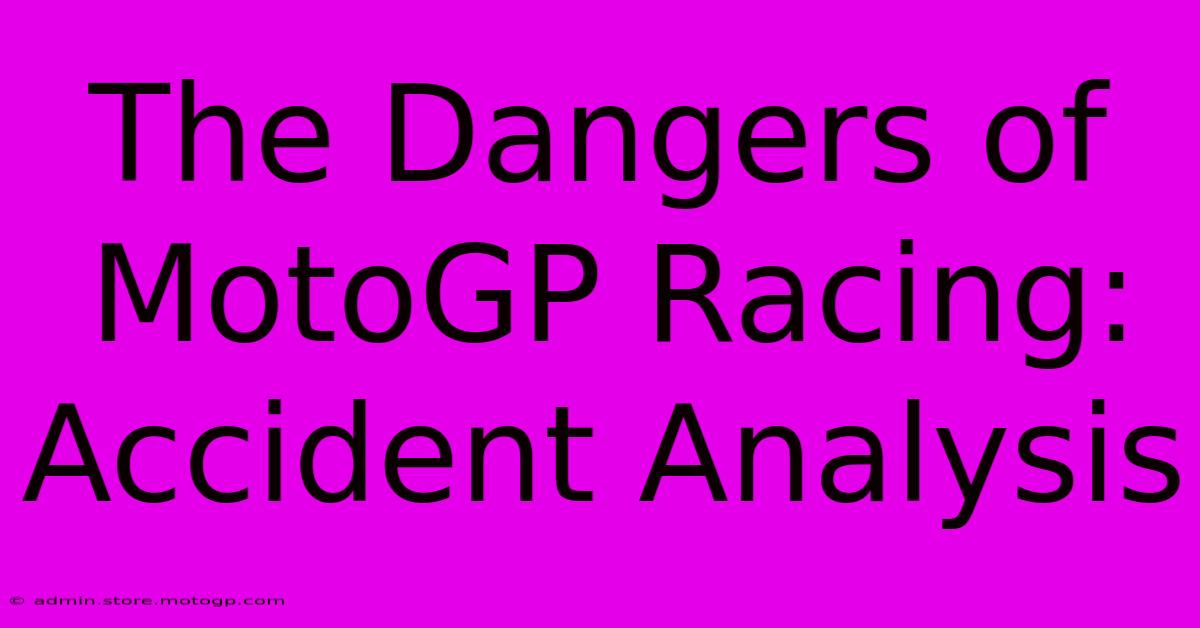The Dangers Of MotoGP Racing: Accident Analysis

Table of Contents
The Dangers of MotoGP Racing: Accident Analysis
MotoGP, the pinnacle of motorcycle road racing, captivates millions with its breathtaking speeds and incredible skill. However, beneath the surface of the adrenaline-fueled spectacle lies a stark reality: inherent and significant danger. This article delves into the dangers of MotoGP racing, analyzing common accident types and exploring the factors that contribute to these high-stakes incidents.
The High-Speed Threat: Understanding the Risks
MotoGP racing pushes the boundaries of human and machine performance. Machines exceeding 200 mph (320 km/h) navigate tight corners and navigate unpredictable track conditions, creating an environment where even minor errors can have catastrophic consequences. The risks are multifaceted, encompassing:
1. High-Speed Crashes: The Most Immediate Danger
High-speed crashes are the most obvious and devastating dangers in MotoGP. The sheer force of impact at such velocities can result in severe injuries, including:
- Traumatic brain injuries (TBIs): A leading cause of serious injury and long-term disability in motorcycle racing. Helmets are crucial, but even the best protection can't eliminate all risk.
- Fractures: Broken bones are common, ranging from collarbones and limbs to more serious spinal fractures.
- Internal injuries: Organ damage from blunt force trauma is a significant concern.
- Burns: From friction with the track surface or contact with the hot exhaust system.
2. Multiple Rider Collisions: The Domino Effect
When one rider crashes, the risk of subsequent collisions increases dramatically. Other riders, unable to avoid the fallen bike or debris, can be involved in a chain reaction, leading to multiple injuries and increased severity of the initial impact. This emphasizes the importance of rider awareness and track positioning.
3. Track Conditions: Weather and Surface Irregularities
Unpredictable weather conditions, like rain, significantly increase the risk of accidents. Wet tracks reduce grip, leading to loss of control and high-speed slides. Surface irregularities, like bumps or debris, can also cause sudden bike instability.
4. Mechanical Failures: Equipment Malfunction
While rigorous safety checks are in place, mechanical failures can occur. Sudden engine failures, brake malfunctions, or tire blowouts can leave riders with little time to react, resulting in crashes. Regular maintenance and rigorous inspections are paramount.
Accident Analysis: Key Factors
Analyzing past MotoGP accidents reveals recurring patterns and contributing factors:
- Rider Error: Human error remains a primary cause of accidents. This includes aggressive overtaking maneuvers, pushing beyond the limits of grip, and misjudgment of braking points.
- Track Design: Track layout and design can influence accident rates. Blind corners, sudden elevation changes, and inadequate runoff areas contribute to higher accident probabilities.
- Tire Wear and Performance: Tire grip is crucial in MotoGP. Excessive wear, improper tire selection, or sudden changes in track temperature can compromise traction and increase the risk of crashes.
Mitigating the Risks: Safety Advancements and Procedures
Despite the inherent dangers, MotoGP constantly strives to enhance safety:
- Advanced Safety Equipment: High-tech helmets, racing suits, and protective gear provide crucial protection.
- Improved Track Safety: Runoff areas, air fences, and medical facilities are constantly upgraded.
- Rider Training and Fitness: Rigorous training programs focus on skills, physical conditioning, and mental preparedness.
- Stricter Regulations: Regulation changes continually address safety issues, incorporating learnings from past accidents.
Conclusion: The Ongoing Battle for Safety
MotoGP racing is a high-risk sport. While accidents are an unavoidable part of the sport, ongoing efforts to enhance safety procedures, improve track designs, and advance protective equipment continuously aim to minimize the risks and protect the riders. Understanding the inherent dangers and analyzing past incidents is crucial for the continued evolution of MotoGP safety measures.

Thank you for visiting our website wich cover about The Dangers Of MotoGP Racing: Accident Analysis. We hope the information provided has been useful to you. Feel free to contact us if you have any questions or need further assistance. See you next time and dont miss to bookmark.
Featured Posts
-
Us Gp Sprint Feel The Thrill Of Victory
Feb 17, 2025
-
Moto Gp Qualifying Decoding The Grid Drama
Feb 17, 2025
-
Cota Events Your Guide To Family Friendly Fun
Feb 17, 2025
-
Racing On A Budget Why Choose A Moto3 Bike
Feb 17, 2025
-
Unlock Austin Your Cota Parking Map
Feb 17, 2025
